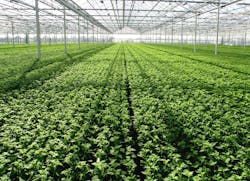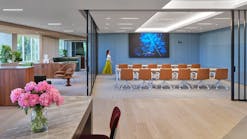Signify gets no pain relief in the second quarter (UPDATED)
Being a lighting all-rounder can be hazardous to the bottom line. Ask Signify, where net income crashed 82% in the second quarter as the company’s solid performance in the outdoor sector couldn’t stave off difficulties in the indoor professional and home markets, as well as in the horticultural lighting segment.
With no immediate change in sight, Signify lowered its profit forecast and said it would implement new “structural changes” on top of cost cuts already under way, which in the quarter ending June 30 included reducing full-time employees from 35,407 to 33,381. Many of the job losses were in factories.
CEO Eric Rondolat cited rising interest rates as one reason why corporate and horticultural customers hesitated to borrow and purchase. Likewise, the inflated cost of energy continues to deter horticultural users from buying LED lighting, he said. Although LEDs are energy efficient, adding them where no lighting has been used before would still incur significant electricity bills.
In the home market, consumers are now spending less on stay-at-home goods such as the company’s Hue and Wiz connected lighting products, and are traveling or going out more in the post-COVID crisis era, Rondolat said. On a call with analysts, he also acknowledged that some consumers are choosing competitors’ less expensive home gear, rather than Signify’s premium priced lighting goods.
The unit sales decline was most likely worse than the euro numbers showed for the Eindhoven, Netherlands–based lighting industry leader. Even though Signify continued to raise prices in the quarter ending June 30, net sales fell to €1.64 billion ($1.8 billion) from €1.84 billion the same quarter a year ago, marking a 10.5% nominal decline, or 8.6% on a comparable basis. Net income cascaded to €45 million ($49.6 million) from €248 million a year ago.
“In the second quarter, we saw continued softness in the consumer, indoor professional, and OEM channels, and a slower-than-anticipated recovery of the Chinese market,” Rondolat said. “Against this backdrop, our actions to improve gross margin are paying off, although fixed costs reduction plans are not yet fully compensating for the volume decline. While our Digital Solutions and Conventional Products divisions demonstrated resilience in their bottom line, our Digital Products division was more exposed to these challenges.”
Digital Solutions includes outdoor and indoor professional lighting plus horticulture; Digital Products includes home LED lamps plus Hue and Wiz smart products; Conventional includes non-LED products.
The range of products areas is the broadest of any lighting company.
Rondolat declined to elaborate on the coming “structural changes.” He said the company would continue to trim down central management operations. It lowered its EBITA margin forecast for the year, to 9.5–10.5%, from what had been 10.5–11.5%. On a positive note, supply chain improvements will push free cash flow generation to the higher end of the previously forecasted 6–8% range, the CEO said.
But overall, whereas last quarter Signify was hoping for a notable second-half improvement, that does not now appear to be the case.
The ongoing downturn in horticulture, for one, will not ease soon.
“Horticulture has a double negative impact to the performance at this point in time,” Rondolat said in response to an analyst’s questions. “The performance last year was extremely strong, especially in Q3. The way this business works is that the decisions are made in the second quarter of the year for the projects that are going to be then implemented in Q3 and Q4.
“This year, given the price of energy, the projects that we are normally able to capture in that business were not implemented by the customers. So it’s a season that is missed because of the high energy costs, and that will not be recovered this year,” he concluded.
While energy prices are trending down, Signify’s horticultural business segment will still have to wait to rebound.
“We will see that business going back to a different level of normality in 2024, but it’s going to be very very tough in 2023,” Rondolat said. “It has impacted our performance and the performance of Digital Solutions quite substantially in Q2, and we believe that it’s going to be pretty much the same in Q3.”
Digital Solutions is the company’s largest business area. Sales declined between 6.5% and 5.7% on a comparable basis — to €974 million ($1.1 billion) from €1.04 billion a year ago, although cost controls and price increases supported a 22% increase in EBIT (income from operations), to €73 million ($80.5 million) from €60 million.
“Comparable sales declined by 5.7%, as continued strength in outdoor professional lighting was more than offset by softness in indoor professional and horticulture lighting,” the company stated, referring to Digital Solutions. “The adjusted EBITA margin increased by 50 bps to 10.0%, mainly driven by gross margin expansion from lower COGS [cost of goods sold] and continued price discipline.”
Rondolat elaborated on other business areas including the IoT and the home market. LEDs Magazine will report on some of these in a separate article.
The company made no reference on the call to its once ambitious push to sell UV-C germicidal products. LEDs requested an update separately.
A year ago, Signify declared some of its UV-C products financially obsolete but was still continuing to sell them. At the end of last year, it discontinued all home UV-C products including those aimed at air, surface, and object disinfection. After the web call, a spokesperson told LEDs that Signify continues to sell into the professional sector both directly and through OEMs.
Rondolat's reference to high interest rates as a sales deterrent marked the second time in a week that a lighting CEO has made that point. Fagerhult CEO Bodil Sonesson noted that borrowing costs are causing high-end buyers to pause on certain projects.
MARK HALPER is a contributing editor for LEDs Magazine, and an energy, technology, and business journalist ([email protected]).
*Updated Aug. 2, 2023 for further detail on UV disinfection business.
Follow our LinkedIn page for our latest news updates, contributed articles, and commentary, and our Facebook page for events announcements and more. You can also find us on Twitter.

Mark Halper | Contributing Editor, LEDs Magazine, and Business/Energy/Technology Journalist
Mark Halper is a freelance business, technology, and science journalist who covers everything from media moguls to subatomic particles. Halper has written from locations around the world for TIME Magazine, Fortune, Forbes, the New York Times, the Financial Times, the Guardian, CBS, Wired, and many others. A US citizen living in Britain, he cut his journalism teeth cutting and pasting copy for an English-language daily newspaper in Mexico City. Halper has a BA in history from Cornell University.





